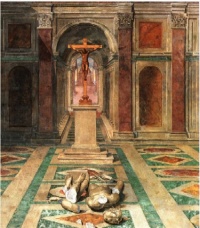Constantinian shift
From The Art and Popular Culture Encyclopedia
(Difference between revisions)
| Revision as of 22:35, 14 July 2010 Jahsonic (Talk | contribs) ← Previous diff |
Current revision Jahsonic (Talk | contribs) |
||
| Line 1: | Line 1: | ||
| + | [[Image:Tommaso.Laureti.Triumph.of.Christianity.jpg|right|thumb|200px|''[[Triumph of Christianity]]'' by [[Tommaso Laureti]] (1530-1602), ceiling painting in the [[Sala di Constantino]], [[Apostolic Palace|Vatican Palace]]. Images like this one celebrate the destruction of ancient [[Paganism|pagan]] culture and the victory of [[Christianity]].]] | ||
| {{Template}} | {{Template}} | ||
Current revision

Triumph of Christianity by Tommaso Laureti (1530-1602), ceiling painting in the Sala di Constantino, Vatican Palace. Images like this one celebrate the destruction of ancient pagan culture and the victory of Christianity.
|
Related e |
|
Featured: |
Constantinian shift is a term used by Anabaptist and Post-Christendom theologians to describe the political and theological aspects of the 4th-century process of Constantine's legalization of Christianity. The term was popularized by the Mennonite theologian John H. Yoder.
[edit]
See also
- Caesaropapism
- Christian anarchism
- Constantinianism
- Constantinople
- Donatists
- Early Christianity
- Erastianism
- Great Apostasy
- Roman Imperial Church
- Sacralism
Unless indicated otherwise, the text in this article is either based on Wikipedia article "Constantinian shift" or another language Wikipedia page thereof used under the terms of the GNU Free Documentation License; or on research by Jahsonic and friends. See Art and Popular Culture's copyright notice.

